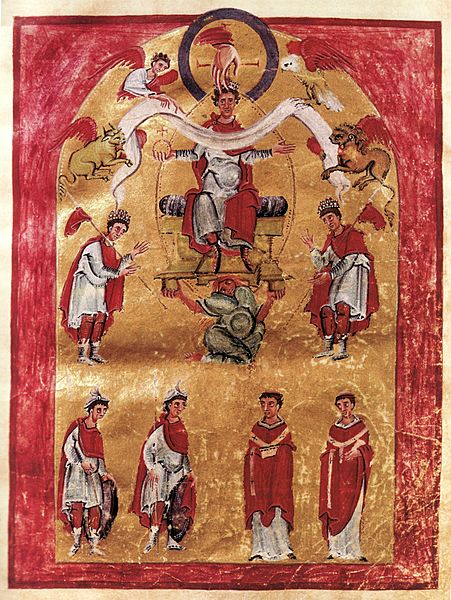Image: Liuthar-Evangeliar

Description: Darstellung Ottos III. aus dem Aachener Liuthar-Evangeliar, fol. 16r. Representation of Otho III, from the Evangeliary of Liuthar, abbay of Reicheneau (see here for black & white photographies of the Evangeliary of Liuthar, on the Bildindex's website). Date: Most sources, such as Eliza Garrison, seem to describe him as Otho III - see in part. footnote 7 on p.10, which finishes by quoting "Ernst Kantorowicz's foundational if problematic analysis of [this] dedication image", in The King’s Two Bodies: A Study in Medieval Political Theology (Princeton: Princeton University Press, 1957), 61-78 ; according to the latter, it would be Otho II, and not Otho III, and the image would have been producted near 973, whereas Garrison notes that "Questions relating to its proper dating have dominated the literature on this manuscript for quite some time, and my own analysis of this work will take as its point of departure Florentine Mütherich‟s suggested range of 983-990 as the correct one for the work‟s date of production. It should be said that this dating is still a matter of debate and some scholars associate this image with the time of Otto III‟s imperial coronation in 996, which took place in Rome." Description: The following description is drawn from Kantorowicz (The King's Two Bodies, III, §2), although we consider this image to be more likely to represent Otho III. This atypical image thus depicts Otho III, holding a royal orb, inside a mandorla, usually used to depict the Christ. He is supported by Terra. The four figures holding the white shawl represents the Four Evangelists (the lion of Mark and the steer of Luke), with the Hand of God (perhaps of Christ, argues Kantorowicz) touching Otho. At the time of Otho II's anointing, hands were not anointed (they were, however, soon after, a detail which gives weight to Kantorowicz's interpretation): this may explain why they are located below the shawl, which would represent the tabernacle or divide between Earth and Heaven. Thus, the upper part of Otho is in Heaven, the lower part on Earth. Two archbishops and two warriors are depicted on the bottom, and one important prince (or reguli, as shown by their crowns) on each side of the stool. The division between three plans (up, center and down) corresponds to representations of the Christ in Majesty in the Apocalypse of Trier or in the Bible of San Paolo. Compare also to the Christ in Majesty in the Vivian Bible (folio 329 here).
Title: Liuthar-Evangeliar
Credit: Wikipedia allemande
Author: ottonischer Buchmaler / Illustrator from the time of the Ottonian dynasty
Usage Terms: Public domain
License: Public domain
Attribution Required?: No
Image usage
The following 2 pages link to this image:

